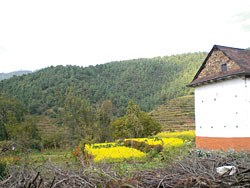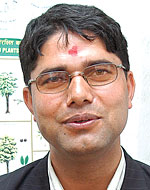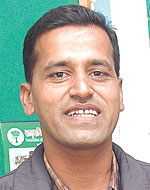|
|
| GOING GOING GONE: Tarai woods are being plundered in broad daylight by timber smugglers, but even the community forests of the Chure like this one near Gaighat are thinning. |
You start seeing them just after forking off at Patlaiya into the East-West Highway. Tractors, lorries, even bicycles, parked on the dirt roads leading out of the jungle on either side. They are heavy with sal logs.
This used to be the famous char kose jhari, the thick hardwood jungle that separated the mountains from the plains. Migration from the hills and from across the border in the past 40 years hasdecimated the trees.
The worst destruction has always happened during periods of political transition-the 1980 referendum, the post-1990 restoration of democracy and this past year.
Ironically, the forests were much better protected during the ten conflict years. There has been a full-scale plunder taking place since the ceasefire and the start of the peace process.
"They have SLRs, we don't even have .303s. They have pickups we have to patrol on foot," says Bhakta Bahadur Regmi, a forest guard at the district forest office in Simara.
The highway robbers and smugglers in the Rautahat corridor are now fully engaged in trucking the timber out of the tarai to India.
Birendra Sah, the journalist who was abducted and killed last month in Bara, had been investigating these gangs. "The lawlessness in the tarai has encouraged the timber mafia, and everyone is afraid of speaking out," says a former DDC member in Rautahat's Chandranigapur. In Dumriya, local officials say up to 700 bicycles carrying small logs cross the border into India every day.
"Even if some tractors are caught, you can openly see the driver paying off the guards," says a farmer in Rautahat's Dhamura. In his village, there is even a saw mill and a depot selling illegally felled trees only 500m off the highway.
Rautahat's DFO Mahendra Chaudhari shrugs it all off: "What do you expect when the prime minister, the ministers and parties are all busy looting the country? The rot starts at the top."
Although community forestry has been a notable success in the mountains, only 2.5 percent of the forests in the tarai is managed and protected by local communities.
"After 20 years of protection, most community forests now have large, mature trees and the gangs are buying off greedy members of user groups,"admits one district official in Udaypur's Gaighat. Earlier, a user group would decide on a policy-what kind of timber to sell and what to use the money for.
During the conflict years, the Maoists took Rs 15 per cubic ft of timber sold as \'tax\'. Despite the peace process, the Maoists are still taxing timber. "Timber smugglers are also bribing some user group members," says one user group chairman here, "but it is getting difficult to tell who is a smuggler and who is a Maoist."
The community forests most at risk are in the Chure range adjoining the plains, which are extremely vulnerable to erosion and therefore are the ones that most need tree cover.
Says the official: "The sal forests of the eastern Chure are in a critical state. If we don't do something about it, Udaypur will be a desert in 10 years."
Healthy hills
 |
On the Dharan-Dhankuta highway, the Charikot-Jiri road and on the way from Syangja to Pokhara logs harvested from community forests are piled neatly by the roadside to be taken to the market. Across Nepal's midhills, the forests are healthy and thick. Community user groups have been using the money from timber sales for local development work.
Today, a quarter of Nepal's forests are managed by local communities. The dense jungles on the slopes above Chitlang are even better protected than national parks, and the only complaint of villagers here is that wild boars and leopards have become a menace. Last year, in a misguided step, the government stopped handing over forests for community management. But such is the demand for community forests that some 5,000 local groups across the country are managing forests even without proper papers.
Kunda Dixit in Makwanpur, with additional reporting by Pranaya SJB Rana
"Let's go from 26% to 100%"
|
|
Nepali Times: The war is over, community forests should be thriving, but we see them being decimated.
Bhola Bhattarai: The government has stopped handing over forests to communities after the war, no one knows why. But there are about 5,000 local communities who have started managing forests on their own even if they have no documents. So, it's not true that woods are dwindling, in fact they are expanding every day. This has made Nepal green again. Still, only 26 percent of all forests in the country are community managed and we have a lot more to do.
What are the post-conflict problems you face?
Bhola Bhattarai: There is always the problem of smugglers and poachers. But that is mostly in nationally-owned forests. If you have an entire village watching over the forest with sticks and knives, poachers are less likely to target those forests. There is a huge problem with the government, and forests are not a priority anymore.
Navaraj Dahal: While handing over the forests, they talk to one or two officials. They are the only ones who know about the forest, the community is not a part of the process. This is the wrong way to do it.
Thakur Bhandari: The problem has never been money. Forest user groups have money in the banks, but communities haven't figured out a way of using the money, and greedy officials have sometimes used it for personal benefit.
How are you tackling these problems?
Thakur Bhandari: Our community user groups have always been inclusive. There has always been 50-50 female participation, and there are groups with only women in them. They are very active.
There are reports that Maoists have forced user groups to give them a cut from forest yield. Any truth to that?
Bhola Bhattarai: Surprisingly, no. Back during the war, the Maoists were very open about extortion, and they did take a lot. But now, it has gone down although there are places where it still continues. As they say, old habits die hard.
Navaraj Dahal: On the Maoist topic, there is one little problem though. The Maoist cantonments have been built right in the middle of community forests, and the houses that they live in are made from fine young trees needlessly chopped down. In Shaktikhor in Chitwan, 300,000 cubic feet of forests were cleared for cantonments. This was a huge mistake.
So what is your strategy for the future?
Bhola Bhattarai: The lesson we have learnt from the past 30 years of community forestry is that the best way to save the forests is to hand over their management to local communities. Just a week back, a timber poacher was stealing wood from a community forest. The chairman of the user group happened to hear of it and rushed to the spot. The poacher beheaded the chairman with his khukuri before rushing off to hide in the local police station. Irate locals surrounded the police station and stoned the poacher to death. The chairman's last words were "Kill me if you will, I won't let you cut this tree." He was a true martyr.
Thakur Bhandari: We now need to go from 26 percent to a full 100. Nepal's forests need to be managed by local communities everywhere, not by the government in Kathmandu.
Bhola Bhattarai: Nepal's community forest is a success story replicated all over the world. This is one sector where Nepal is showing the way. We should build on it.






